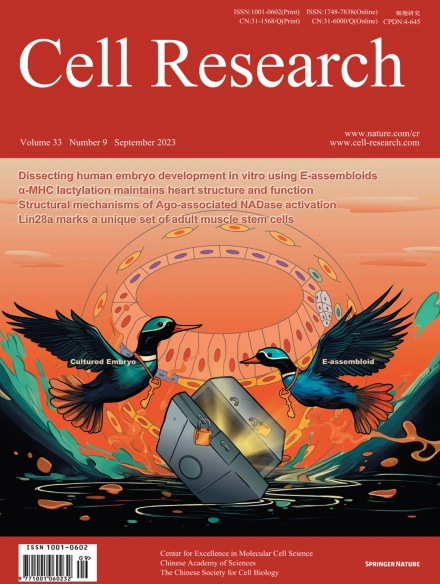
Advanced Search
Submit Manuscript
Advanced Search
Submit Manuscript
Volume 33, No 9, Sep 2023
ISSN: 1001-0602
EISSN: 1748-7838 2018
impact factor 17.848*
(Clarivate Analytics, 2019)
Volume 33 Issue 9, September 2023: 679-698 |
α-myosin heavy chain lactylation maintains sarcomeric structure and function and alleviates the development of heart failure
Naijin Zhang1,2,† , Ying Zhang1,3,† , Jiaqi Xu1 , Pengbo Wang1 , Boquan Wu1 , Saien Lu1 , Xinxin Lu1 , Shilong You1 , Xinyue Huang1 , Mohan Li1 , Yuanming Zou1 , Mengke Liu1 , Yuanhui Zhao1 , Guozhe Sun1 , Wenbin Wang1 , Danxi Geng1 , Jingwei Liu4,5 , Liu Cao4,5 , Yingxian Sun1,3,6,*
1Department of Cardiology, First Hospital of China Medical University, Shenyang, Liaoning, ChinaThe sarcomeric interaction of α-myosin heavy chain (α-MHC) with Titin is vital for cardiac structure and contraction. However, the mechanism regulating this interaction in normal and failing hearts remains unknown. Lactate is a crucial energy substrate of the heart. Here, we identify that α-MHC undergoes lactylation on lysine 1897 to regulate the interaction of α-MHC with Titin. We observed a reduction of α-MHC K1897 lactylation in mice and patients with heart failure. Loss of K1897 lactylation in α-MHC K1897R knock-in mice reduces α-MHC–Titin interaction and leads to impaired cardiac structure and function. Furthermore, we identified that p300 and Sirtuin 1 act as the acyltransferase and delactylase of α-MHC, respectively. Decreasing lactate production by chemical or genetic manipulation reduces α-MHC lactylation, impairs α-MHC–Titin interaction and worsens heart failure. By contrast, upregulation of the lactate concentration by administering sodium lactate or inhibiting the pivotal lactate transporter in cardiomyocytes can promote α-MHC K1897 lactylation and α-MHC–Titin interaction, thereby alleviating heart failure. In conclusion, α-MHC lactylation is dynamically regulated and an important determinant of overall cardiac structure and function. Excessive lactate efflux and consumption by cardiomyocytes may decrease the intracellular lactate level, which is the main cause of reduced α-MHC K1897 lactylation during myocardial injury. Our study reveals that cardiac metabolism directly modulates the sarcomeric structure and function through lactate-dependent modification of α-MHC.
https://doi.org/10.1038/s41422-023-00844-w